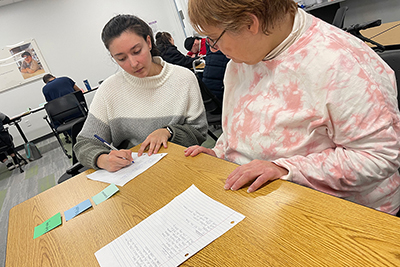Autistic, Not Sorry
Monday, March 20, 2023
You’ll probably learn something about dogs when you meet Isabelle Morris (pictured at left), and after letting you know she has all of the AKC breeds memorized alphabetically, she’ll joke that if you couldn’t already tell, her other special interest is autism.
But it’s not just uncanny canine knowledge and a dry sense of humor that set Morris apart. She’s among a growing group of autistic researchers using their lived experience to shape the future of autism research.
“I only have one experience of autism, and my adviser and others around me have the good sense to not challenge the person with autism on their experience, but to encourage me to bring in other people who will make my research so much better, versus conducting it in a vacuum,” Morris said. “It’s not only better-quality research, but community building.”
Morris is a second-year doctoral student at the University’s Institute of Child Development who is also completing a MNLEND fellowship at the Institute on Community Integration. The Minnesota Leadership Education in Neurodevelopmental and Related Disabilities fellowship is a leadership training experience that spans more than 16 disciplines across the University and includes a wide cross section of community members from outside the University.
Her participatory research project is called RADAR (Research on Autism Driven by Autistic Researchers) and her small group of collaborators are exploring perceptions about and experiences with stimming, the repetitive self-stimulating behaviors sometimes used by people with autism to manage emotions. They recently completed a survey of 150 U.S. adults with autism, asking them about masking (methods used to hide stimming from public view), about the positive and negative ways stimming affects them, and about how they use stimming to communicate with other autistic people and express their identities. She plans to conduct 20 follow-up interviews, analyze both sets of findings, and use them to create a better understanding of the way autistic people communicate.
“Historically, stimming was deemed as purposeless behavior,” said Morris, who did her undergraduate work at Stanford University and spent two years at the Stanford Neurodiversity Project. “Today there’s a recognition that it helps in self-regulation, but this social communication aspect is new. Rather than looking at it as a comparative deficit, it acknowledges an autistic’s way of being in the world.”
In the survey, nearly 3 in 4 respondents said that when they see other neurodivergent people stimming, they can tell what emotions the person is feeling – quite remarkable for a population that has historically been thought of as not being capable of reading emotions, Morris said.
“Who lacks theory of mind, now?” she quips, often referring to herself as “unapologetically autistic.”
By deeply engaging autistic people in research, we learn much more, she said. “We often joke that this is the autistic social club where we talk about research.”
To help hone her skills in working with people with different types of disabilities at multiple levels of a research project, she also spent time through her MNLEND fellowship working with Cow Tipping Press , a Minneapolis organization that teaches inclusive writing classes for adults with developmental disabilities. Her class will host readings and a book launch showcasing their work at 11 a.m. on April 4 at Lake Monster Brewing in St. Paul. Information on other spring book events can be found here.
Leading the course was challenging for Morris, stretching her executive functioning capacity, but it also helped her confidence in working with people with disabilities.
“I really want to include people with intellectual disability and higher support needs in my research,” she said. “This experience gave me the opportunity to presume competence and provide support. It also gave me ideas on how to integrate people with ID into my research in a meaningful way. LEND has been a huge complement to my academic training. Now I have a little more experience and an ability to bring that into my research with collaborators. It’s all interconnected.”
